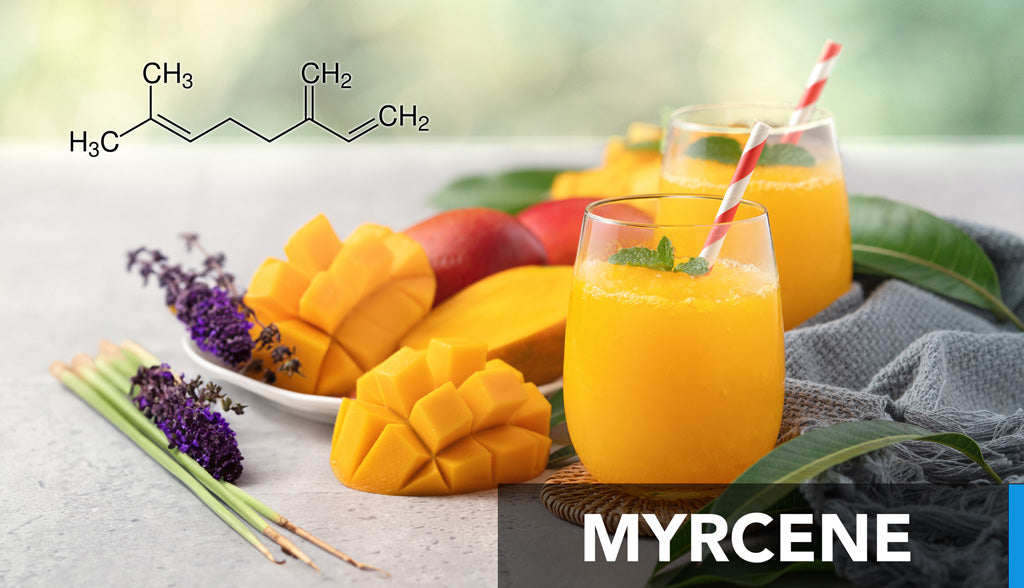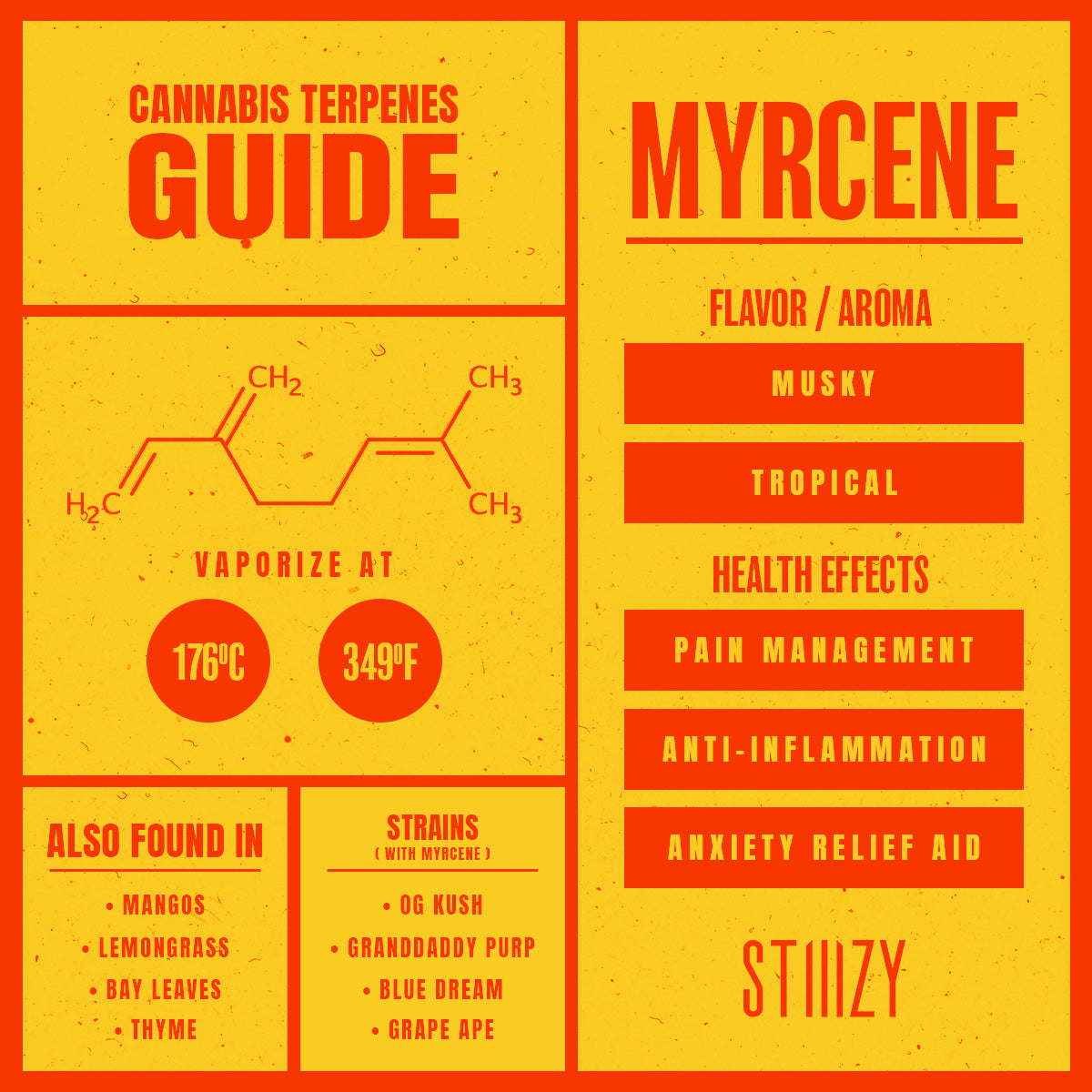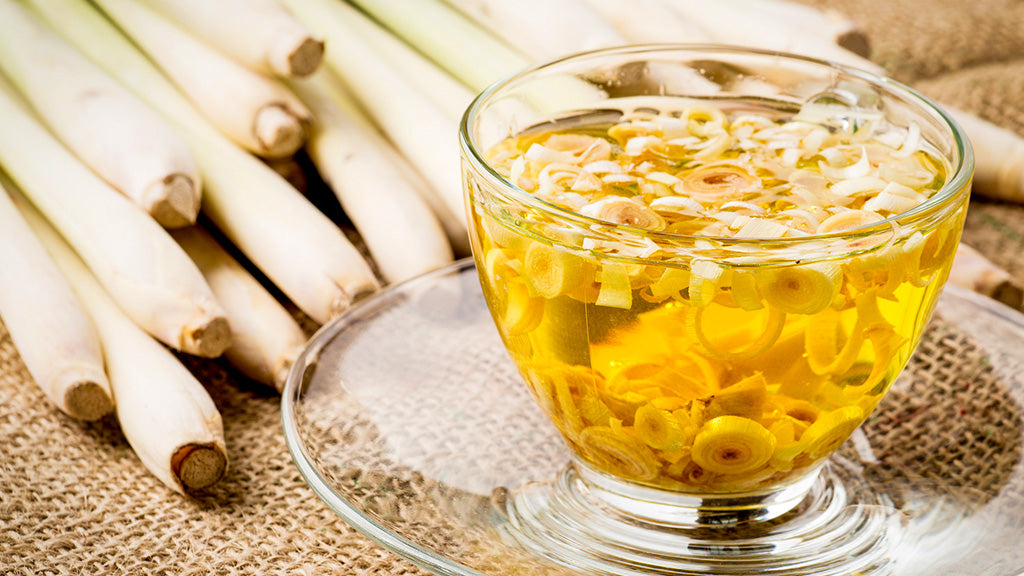Myrcene Effects to Your Cannabis Experience

Myrcene (7-Methyl-3-methylene-1,6-octadiene) is a fascinating monoterpene that presents in a variety of plants and carries an array of intriguing effects. Myrcene, or β-myrcene, is a colorless oil that is commonly found in essential oils, emanating an enchanting peppery and balsamic aroma that adds a unique flavor to beer.
Due its alluring scent, myrcene is typically used as a valuable intermediate in the perfumery industry for the preparation of various fragrances, like menthol, citral, citronellol, citronellal, limonine, geraniol, nerol, and linalool.
You'll find that myrcene is mostly produced semi-synthetically from a plant called Myrcia, hence the name, and can also be manufactured commercially by the pyrolysis of β-pinene, derived from turpentine.
Though not often directly extracted from plants, myrcene is abundant in a myriad of them, including verbena, wild thyme, bay leaves, hops, Houttuynia, lemongrass, mango, West Indian bay tree (Pimenta racemosa), and cardamom.
Interestingly, the largest monoterpenes fraction in Humulus lupulus (hops) is β-myrcene, and it's also thought to be the predominant terpene found in modern cannabis cultivars within North America.
The Aroma of Myrcene
A scent that whirls you into a labyrinth of earthy tones, myrcene's aroma is a sensory experience that is both spicy and musky, with a mildly sweet tinge. Strains with higher level of myrcene can carry subtle sweet undertones reminiscent of ripe mango, juicy guava, and other exotic fruity flavors.
Before we dive into the ocean of myrcene effects, let's pause for a moment and understand the nature of the terpenes found in cannabis itself. Terpenes, like myrcene, are not just the flavor or aroma agents of the cannabis plant; they are the bodyguards, the interacting agents, the impact multipliers.
Their interaction with other components, including other cannabinoids themselves, sparks what is known as the 'entourage effect', a symphony of elements working together to create a unique and personalized impact.
How Myrcene Affects Cannabis Experience
Myrcene terpene holds a special place in the world of cannabis, not just for its earthy, pleasant aroma alone, but also for its ability to alter the effects of a strain.
Often referred to as the "gateway terpene," myrcene accelerates the absorption rate of other substances, including cannabinoids, by increasing the permeability of cell membranes. Thus, if a strain has pain-relieving effects, myrcene might amplify those to a certain extent.
Many cannabis strains are rich in myrcene, offering a variety of effects and experiences. You'll find high concentrations of myrcene in cannabis strains like OG Kush, Granddaddy Purp, Pineapple Express, Blue Dream, Grape Ape, and Lemon Haze, among others.

Understanding the Effects of Myrcene
In the realm of cannabis, myrcene steps into the spotlight as one of the most abundant terpene representing over 20% of the terpene profile on average, although individual samples do vary considerably. If you find yourself picking a random flower product off a dispensary shelf, there's a 40% chance that it's myrcene-dominant, reflecting its dominance in the cannabis market.
The Indica-Sativa Dichotomy
A common claim you may hear in the cannabis community is that the levels of myrcene terpene in a strain can predict its effects - whether it leans more towards the relaxing indica or the energizing sativa.
Specifically, it's often stated that strains with more than 0.5% of myrcene content by weight will produce indica effects, while strains with less than 0.5% of myrcene content will produce sativa effects.
However, the reality is more nuanced than this rule suggests. When we delve into lab data, we find that myrcene levels across indica, hybrid, and sativa strains tend to be quite similar, indicating that the relationship between myrcene levels and strain effects is not as straightforward as it might seem.
Sedative Effects & Muscle Relaxant
The sedating effects of myrcene may be a subject for debate. This claim may have originated from the common belief that myrcene has sedative effect and that myrcene may be responsible for the "couch lock" effect many consumers sometimes feel with cannabis consumption.

Indeed, herbal medicines containing myrcene like lemon grass have a long history of being used as a sleep aid in folk medicine. In Mexico, myrcene-rich lemongrass infused tea has been used as a sedative and muscle relaxant, and in Germany, myrcene-rich hops preparations are commonly used as a sleep aid.
A limited number of animal studies have suggested that high doses of myrcene may have muscle relaxant effects and can increase the amount of time mice spend asleep, especially when given in combination with strong sedatives.
However, it's important to note that these findings often do not directly translate to humans, and more research is needed before we can conclusively establish whether myrcene can produce sedative and muscle relaxant effects in humans, especially at the levels commonly found in commercial cannabis products.
The Entourage Effect and Myrcene's Role
The entourage effect postulates a synergistic relationship between myrcene represents the diverse compounds found in the cannabis plant itself, resulting in amplified benefits compared to isolated compounds.
This symbiotic effect is believed to intensify the effects of THC, potentially reducing THC tolerance without lowering consumption. Furthermore, it may increase blood-brain-barrier permeability and harmonize with other cannabinoids.
Myrcene in Different Forms
Myrcene's presence isn't exclusive to cannabis. For example, a fresh mango could contain 5-10mg total terpenes, with myrcene likely to account for fractions of a milligram.
Cannabis however, is a rich source of myrcene, with high-quality strains containing between 5-20mg per gram. As an example, a gram of herbal cannabis with 20% THC and 2% myrcene contains 200mg THC and 20 mg myrcene.
In the world of edibles and supplements for instance, a terpene supplement shot could contain a dose of 15mg myrcene, and a terpene-enhanced edible could have a few milligrams of each terpene.
Consumption and Absorption
The route of administration plays a significant role in myrcene's effects. Inhalation of cannabis might lead to a rapid absorption and distribution of cannabinoids, and possibly terpenes like myrcene.
This is due to increased bioavailability from inhalation and high concentration in cannabis, supporting the hypothesis that myrcene may meaningfully contribute to the therapeutic and psychotropic effects of cannabis.
However, oral consumption of myrcene, such as in edibles and supplements, may not lead to similar effects. It appears that cannabis terpenes don't absorb as well into the bloodstream through the gastrointestinal (GI) tract, and absorption can vary significantly between different terpenes. For instance, a pharmacokinetic study suggests the oral bioavailability of myrcene to be approximately 22%, albeit with a substantial margin of error.
While there's a wealth of anecdotal claims and industry narratives about myrcene's effects, it's important to emphasize that the scientific understanding of myrcene's pharmacokinetics (the movement of drugs within the body) and pharmacodynamics (the effects of drugs and the mechanism of their action) is still evolving. More rigorous clinical studies are required to uncover the full extent of myrcene's effects, its interactions with other cannabinoids, and its potential health benefits.
Potential for Pain Management
Myrcene has an uncanny knack for pain relief. The synergy with THC form an alliance that could potentially enhance the analgesic effects and pain relieving properties of the cannabis plant.
For Neuropathic Pain
Myrcene's effects on pain may not stop at general analgesia. It seems to have a soft spot for neuropathic (nerve) pain, too - a type of chronic pain often caused by damage to the nervous system. Preliminary research hints at myrcene's potential to soothe this hard-to-treat pain. Low dose vaporized cannabis has also shown to significantly improves neuropathic pain.
As we push the boundaries of our understanding of myrcene and its potential effects on treating pain, it's essential to remember that myrcene research is ongoing.
Anti-Inflammatory Properties
Myrcene has been increasingly recognized for its remarkable anti-inflammatory effects. Its efficacy has been tested and proven in various scientific studies, offering a new perspective on potential therapeutic applications. In fact, myrcene's anti-inflammatory properties could very well be one of its most compelling attributes.
To understand the effects of myrcene, it is important to delve into the scientific evidence supporting its anti-inflammatory properties. One significant study conducted a screening of several compounds, including myrcene, for their anti-inflammatory, anti-catabolic, and pro-anabolic activities in human chondrocytes, which are the cells found in healthy cartilage.
One of the remarkable findings of the study was that myrcene was successful in inhibiting IL-1β-induced nitric oxide production at non-cytotoxic concentrations. Nitric oxide, in large amounts, can lead to inflammation, indicating that myrcene's ability to control its production can help manage inflammatory responses in the body.
The Regulation of Inflammatory and Catabolic Genes
Furthermore, myrcene was found to decrease the activation of NF-κB, JNK, and p38, all of which are significant players in the inflammatory pathway. More impressively, myrcene was also capable of reducing the expression of inflammatory (iNOS) and catabolic (MMP-1 and MMP-13) genes, while simultaneously boosting the expression of anti-catabolic genes (TIMP-1 and -3).
Myrcene's Role in Cartilage Health
Another critical aspect of myrcene's anti-inflammatory properties is its role in maintaining cartilage health. While the compounds tested in the study, including β myrcene, were not able to reduce inflammation or to increase the expression of cartilage matrix-specific genes (collagen II and aggrecan), they were successful in preventing the increased expression of the non-cartilage specific gene, collagen I, that was induced by IL-1β.
This ability to reduce inflammation and inhibit the deterioration of cartilage health demonstrates myrcene's potential as a protective agent against cartilage destruction and osteoarthritis progression.
All in all, the science paints a promising picture of myrcene's anti-inflammatory effects. Its ability to regulate critical genes, reduce inflammation, control nitric oxide production, and protect cartilage makes it a potentially powerful tool in the fight against chronic inflammatory conditions.
While more research is needed to fully understand its mechanisms, the existing evidence undeniably underscores the potential of myrcene in anti-inflammation therapy.
Anxiety Relief Aid
Myrcene anxiolytic properties has been linked to reducing anxiety and stress levels, acting like a much-needed balm for an overactive mind. Moreover, it's not just the mind that benefits. The body, too, reaps rewards as myrcene displays noteworthy sedative and muscle relaxant effects, helping to foster overall relaxation.
Dual Forms of Myrcene
Myrcene comes in two different forms: alpha (a-myrcene) and beta myrcene (b-myrcene). Both forms are found in cannabis, with a-Myrcene being the more common variant. Interestingly, both forms have been shown to reduce anxiety and produce sedative effects, making myrcene a versatile agent for those seeking potential therapeutic benefits.
Potential Anti-Tumor Properties
Scientists have long observed a connection between inflammation and tumors. This link is not surprising, given that inflammation can often be a trigger for cellular changes, including those that lead to cancer.
If a terpene, like myrcene, has anti-inflammatory effects, it stands to reason that it could also have anti-tumor effects. This opens up new avenues of study for researchers interested in the therapeutic potential of myrcene.
Myrcene and Cancer Cells
A group of Korean scientists has ventured into this uncharted territory, conducting studies on human breast cancer cells. The results were intriguing. They found that myrcene may discourage the metastasis or spreading of these cells.
While it's not yet definitive that myrcene can prevent cancer from reaching a more serious stage, these early findings are encouraging and suggest that further research is warranted.
While it's important to note that the research on myrcene's potential anti-tumor effects is still in its early stages, the signs are promising. The findings of these studies could potentially pave the way for new strategies in cancer prevention and treatment.
Myrcene and the Immune System
Inflammation is a typical response of our immune system to invaders. However, chronic inflammation can lead to various health problems, from heart disease to autoimmune disorders. Myrcene, with its potential anti-inflammatory properties, might aid in regulating our body's inflammatory response to support our immune health.
Myrcene is also thought to possess antioxidant activity. Antioxidants are substances that help protect our cells from free radicals, unstable molecules that can cause damage if levels become too high in the body. By potentially neutralizing these harmful molecules, myrcene contributes to a healthier immune system.
While preliminary, some studies suggest that myrcene could have immunomodulatory effects. This means it might help balance the immune response, preventing it from becoming overactive or underactive.
The purported immune-boosting effects of myrcene are intriguing, to say the least. But as with any natural compound, it's important to approach with a measured optimism.
Appetite Suppression
While many people associate cannabis use with "the munchies," certain cannabis strains high in myrcene might actually help keep those snack cravings at bay.
Appetite regulation is a complex process influenced by various factors, including hormonal signals and neurotransmitters in the brain. Myrcene is believed to interact with the endocannabinoid system, which plays a crucial role in regulating appetite and food intake.
It is important to note that the research in this area is still in its early stages, and further studies are needed to fully understand the mechanisms and extent of myrcene's impact on appetite.
Conclusion
In the exciting realm of plant-based compounds, myrcene, a major constituent in many plant species, stands out as a star player due to its potential health benefits and wide-ranging applications.
Though myrcene is traditionally renowned for its distinctive aroma and flavoring properties, recent research has revealed it to be a powerful biological agent, boasting impressive anxiolytic, antioxidant, anti-ageing, anti-inflammatory, and analgesic properties. In fact, these diverse effects make myrcene a compelling subject for further exploration and experimentation.
While the current body of research on myrcene is largely based on animal studies, the results are promising enough to warrant further investigation in human trials. Indeed, the lack of comprehensive human studies is a gap that needs to be filled, but this does not diminish the potential of myrcene's beneficial effects.
The safety profile of myrcene also contributes to its appeal. With recent data reinforcing its safety, myrcene could become an increasingly common component in various products, from food and beverages to therapeutic agents.
Looking forward, we can anticipate the rise of innovative products leveraging the health benefits* of myrcene. Non-alcoholic beers, functional foods and drinks, and even cannabis extracts low in THC but rich in myrcene content could soon become a reality, further expanding the applications of this versatile terpene.
Overall, the study of myrcene and its effects presents an exciting frontier in the field of plant-based therapeutics. As we continue to explore chemical compounds and understand the myriad ways myrcene interacts with our bodies, we can look forward to harnessing its full potential for the betterment of human health.
The content provided on this blog is for informational purposes only and is not intended as professional medical advice, diagnosis, or treatment. Please consult with your healthcare provider and local laws before purchasing or consuming cannabis.

